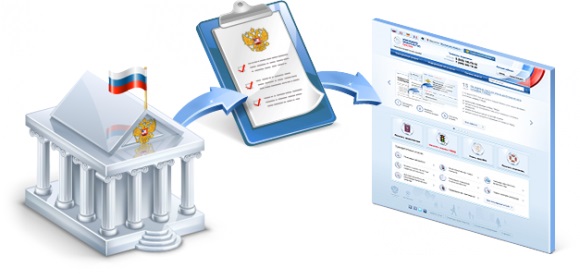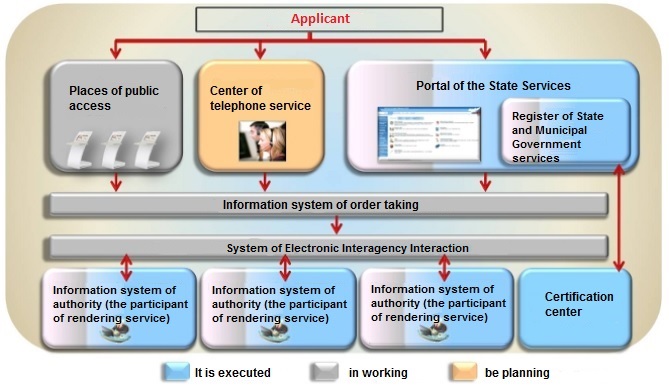The interaction approach of public authorities in the E-government

The value of time comes to the forefront in the century of high technologies. The principle of people line becomes irrelevant, it is succeeded by electronic queue. The Electronic Russia Federal Target Program was created at the federal level. Within this program in October, 2011, the E-government (Electronic Government) project started, urging to change relationship between society, thereby having ensured effective functioning of administration. Public authorities of any level now could cooperate among themselves without creating own social networks and portals. One of such ways of communication is the Portal of the State Services which allows to obtain information on the state services, an order of their presentation and registration.
Being an expert in the subject, the employee of Ardecs has explained the concept of public authorities’ interaction in the E-government. He also has told about changes of the System of Electronic Interagency Interaction (SEII) over the last two years.
The System of Electronic Interagency Interaction is the rule system that allows departments to exchange data. These rules include the data format, exchange order and other services. Technically, each department has its own interactive service that works with similar services in other departments. This system was established in frames of Federal Target Program in order to compound the intergovernmental information systems (E-services) and to provide the further interaction.
Let us have a look at the cooperation process of two Government authorities. A citizen appeals to the local authority with the formal application for service provision, i.e. to renew the Russian passport at 20 or 45 years old. The Government authority should make an information request from another department to gain the relevant information about this service. In terms of internal organization, the System of Electronic Interagency Interaction was particularly developed to carry out this service.
The aims of the System of Electronic Interagency Interaction in the E-government infrastructure are the following:
1. Governmental functions in electronic form. The providing with state and municipal service and the administration of state and municipal functions in the Internet.
2. State service in electronic form. The providing with state and municipal service in Internet access, also applying federal state Internet system "Common Government Services Portal of Russian Federation".
3. The system bus of information interaction. Technical support of information interaction applying interaction system is reached by service architecture usage that contains a set of Internet services that are built according to common standards, including the usage of common technical solutions, standards, qualifiers and the data structure descriptions.
The system helps to realize the rule of "one window" rendering state services to citizens. The citizen asks for service at a department and the experts find required data in other departments using SEII. The way of rendering of State and Municipal Government services through SEII is represented on the picture 1.

Pic. 1. Scheme of rendering services
The participants of the System of Electronic Interagency Interaction (SEII) are providers and users of data:
- each data provider registers his own Internet service that is intended for the requests processing and data delivery in SEII;
- each data user registers his own adapter that can ask and get data correctly in SEII.
The operator of the System of Electronic Interagency Interaction is Russian Ministry of Connections and Public Communication.
Just recently the State Authorities and local self-government have started to use SEII 3 - the new version of the System of Electronic Interagency Interaction. SEII 3 is provided with a data type register (hereinafter – data register), required for delivery of State and Municipal Government services and performance of State and Municipal Government functions and their formats.
Under information exchange of Informational System (hereinafter - IS), the deliverer and the client exchange messages. IS, which sends a message through SEII 3, is the message sender, and IS, which receives a message from SEII 3, is the receiver. More simply, the process of message exchange between the client’s IS and the deliverer’s IS through SEII 3 includes the following steps (pic.2):
- request forwarding from the client’s IS to SEII 3;
- request placing in SEII 3 in the deliverer’s request line;
- request receiving by the deliverer’s IS from SEII 3;
- preparing a response for request by the deliverer;
- forwarding the response prepared from the deliverer’s IS to SEII 3;
- response placing in SEII 3 in the client’s response line;
- response receiving by the client’s IS from SEII 3.

Pic. 2. Process of an exchange of messages in SEII 3
In SEII 3 interaction is performed in asynchronous mode like via e-mail. Each operation of message forwarding / receiving (with request or response) is implemented through invoke of relevant method of the united SEII 3 e-service. Message forwarding through SEII 3 is accomplished with the line-method.
The concept of data types is used for queries addressing instead of the concept of access point (endpoint). Since the interpellation is made as a XML-document, the type of information can be uniquely identified using the full name of the root element of the document. This is possible, because any XML-document scheme must have a globally unique namespace schemes and one scheme inside a root-level element names must be unique. One of the functions of SEII 3 is a technical control of unique spaces for scheme names. Based on the type of information, SEII 3 can determine, which vendor an inquiry should be directed to.
In addition to the immediate delivery requests and responses SEII 3 offers the possibility of organizing a broadcast messaging and message priority delivery mechanisms.
Summarizing, we can conclude that the system of interaction between public authorities (SEII) allows solving a number of important tasks in public administration:
• to speed up the interaction of public authorities with citizens;
• to speed up the interaction among the public authorities;
• to reduce the Government expenses.
Thus, the E-government is an adaptation of public administration to the new requirements of social development. This project includes the direct services provided by the state (i.e., public authorities and local Government) to its citizens, and interaction between them, in particular, because of the support and implementation of feedback communication system (citizen - Government - citizen), and vice versa, using modern communication technologies.












